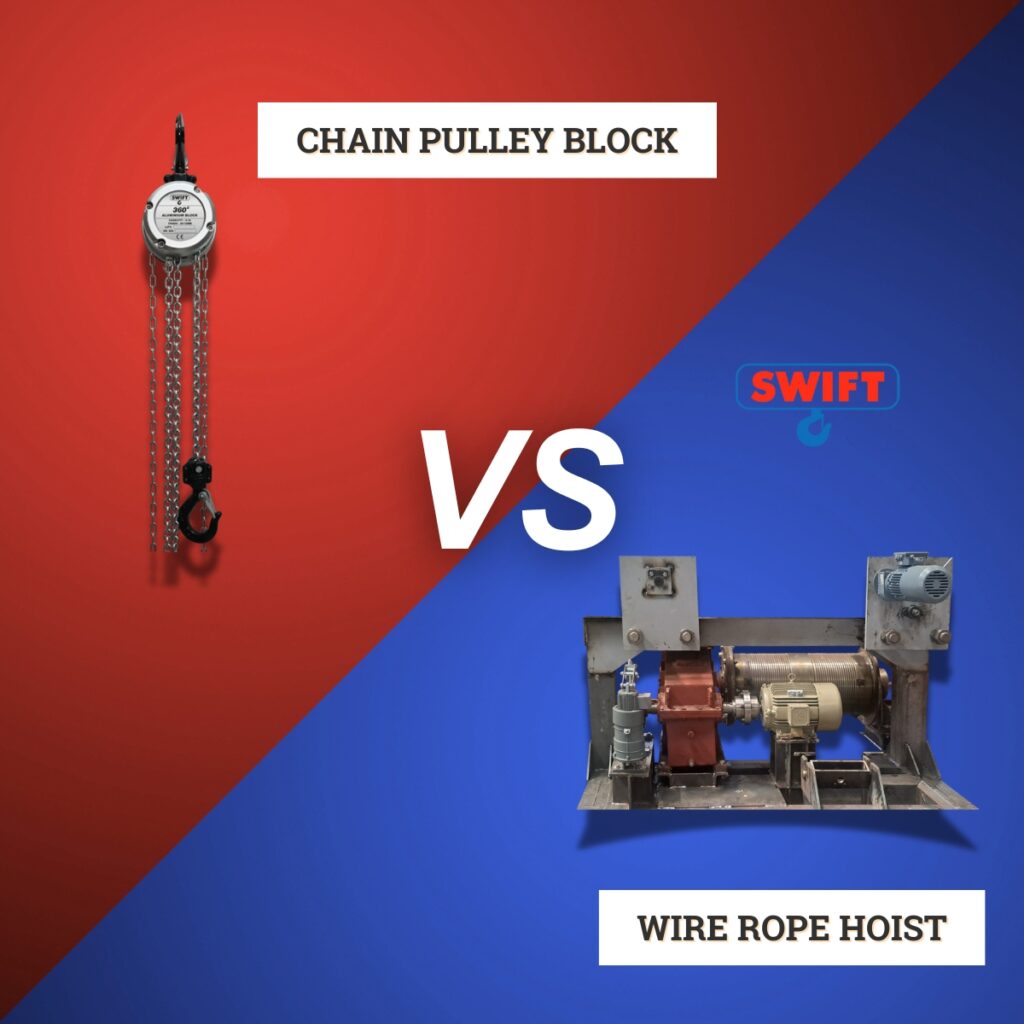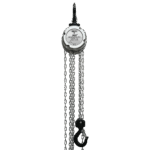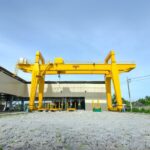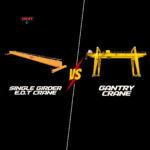In material handling, lifting equipment is the backbone of safe and efficient operations. Among the most widely used devices are Chain Pulley Blocks (CPBs) and Wire Rope Hoists (WRHs). Both serve the same purpose lifting and moving heavy loads but they differ significantly in design, operation, and applications.
For buyers, engineers, and operators, the challenge often lies in knowing which hoist suits their specific job. Should you opt for the simplicity of a chain pulley block or the power of a wire rope hoist? This guide breaks down the differences and helps you make an informed choice.
Understanding the Basics
Before comparing the two, it’s important to understand what each device is and how it functions in material handling operations.
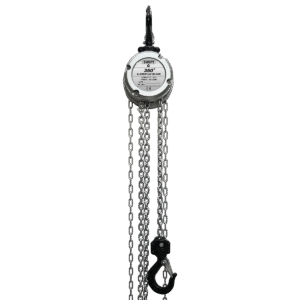
What is a Chain Pulley Block?
A Chain Pulley Block is a manual device that uses a combination of gears, pulleys, and a hand-operated chain to lift loads vertically. Its key advantage lies in its simplicity and portability.
At SWIFT, models like the Troy, Rush, 360° Degree Chain Pulley Block and 360° Aluminium Chain Pulley Block are built for different needs, from rugged medium-duty operations to lightweight, portable applications.
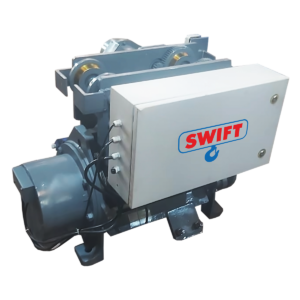
What is a Wire Rope Hoist?
A Wire Rope Hoist is a powered lifting device that uses wire ropes wound around a drum to lift heavy loads. Operated electrically, these hoists deliver speed, precision, and higher capacities compared to manual hoists.
SWIFT offers a wide range of Wire Rope Hoists, from standard compact designs to flame-proof models and heavy-duty open winch hoists with lifting capacities up to 40 tons and lift heights up to 75 meters.
8 Key Comparison Points
When deciding between a chain pulley block and a wire rope hoist, it’s not just about choosing one over the other—it’s about matching the equipment to your specific lifting needs. Factors like load capacity, speed, frequency of use, safety, and cost play a major role in determining which option will deliver the best performance and value. Below, we break down eight critical comparison points to guide your decision.
1. Load Capacity
Load capacity, often referred to as Safe Working Load (SWL), is the first factor to evaluate when selecting lifting equipment.
-
Chain Pulley Blocks are generally suitable for moderate to heavy loads, and they are best used where manual effort is practical and power is not available.
-
Wire Rope Hoists can handle a broader range, with open winch designs extending even further for heavy-duty applications.
👉 Our chain pulley blocks are designed for loads up to 10 tons, while our wire rope hoist supports capacities up to 40 tons, ensuring solutions for both medium-duty and heavy-duty lifting needs.
2. Power Source
-
Chain Pulley Block: Operated manually, requiring human effort. Commonly used in remote or power-restricted areas.
-
Wire Rope Hoist: Powered electrically, ensuring smooth, fast, and less labour-intensive lifting.
👉 This makes CPBs ideal for workshops or temporary setups, while WRHs excel in large-scale industrial environments.
3. Lifting Speed
-
Chain Pulley Block: Slower, as it depends on manual chain pulling. Best suited where speed is not a priority.
-
Wire Rope Hoist: Much faster, with the ability to incorporate Variable Frequency Drives (VFDs) for micro-speed and precision lifting.
4. Frequency of Use
-
Chain Pulley Block: Suitable for occasional lifting tasks. Frequent use can lead to operator fatigue.
-
Wire Rope Hoist: Designed for continuous and repetitive operations, making them ideal for production floors, warehouses, and assembly lines.
5. Precision and Control
-
Chain Pulley Block: Offers reliable control but with limited precision.
-
Wire Rope Hoist: Advanced control panels, overload protection, and brake systems ensure high precision in lifting and lowering.
👉 SWIFT WRHs include fail-safe brakes, micro-speed controls, and overload relays to enhance safety and accuracy.
6. Space and Installation Requirements
-
Chain Pulley Block: Compact, lightweight, and easy to install. Can be set up on beams, tripods, or scaffolds.
-
Wire Rope Hoist: Requires structured installation on cranes or beams, often with more space and power arrangements.
7. Maintenance Needs
-
Chain Pulley Block: Low-maintenance with fewer moving parts. Spare chains and hooks are easily replaced.
-
Wire Rope Hoist: Requires more regular servicing due to motors, ropes, and control systems, but offers long-term efficiency when maintained properly.
👉 SWIFT ensures both CPBs and WRHs come with strong after-sales support and easily available spares.
8. Cost of Ownership
-
Chain Pulley Block: More economical in terms of purchase and upkeep, especially for smaller loads.
-
Wire Rope Hoist: Higher upfront cost, but the efficiency, speed, and productivity gains justify the investment in the long run.
When to Choose a Chain Pulley Block
-
Occasional lifting in workshops, warehouses, or small-scale industries.
-
Environments without access to a power supply.
-
Compact spaces where portability is key.
-
Cost-sensitive projects requiring basic lifting.
👉 SWIFT Options: The 360° Chain Pulley Block is excellent for confined spaces with its rotating hand wheel, while the 360° Aluminium variant offers portability for industries requiring hygiene and mobility.
When to Choose a Wire Rope Hoist
-
Continuous lifting operations in factories, shipyards, and heavy industries.
-
Jobs requiring higher lifting heights and capacities.
-
Projects needing speed and precision handling.
-
Environments where safety compliance and certifications are critical.
👉 SWIFT Options: Standard wire rope hoists cover up to 15 tons, while open winch wire rope hoists extend to 40 tons and lift heights of 75 meters.
Combination Use Cases
In many industries, both solutions coexist:
-
A chain pulley block for small, infrequent lifts or backup.
-
A wire rope hoist for primary, high-capacity, continuous lifting tasks.
This combination ensures flexibility while optimising investment.
Conclusion
Both Chain Pulley Blocks and Wire Rope Hoists are indispensable in material handling—but their suitability depends on your operational needs. Chain pulley blocks are economical, portable, and effective for occasional lifting, while wire rope hoists deliver speed, capacity, and precision for continuous heavy-duty use.
At SWIFT, we offer a complete range of both CPBs and WRHs each engineered for safety, reliability, and performance. Whether it’s the rugged Troy and versatile Rush chain pulley blocks or our advanced wire rope hoists with capacities up to 40 tons, we ensure you have the right solution for every lifting challenge.
📩 For enquiries, write to us at: enquire@csil.in
📞 Call us at: +91 9403 89 2303
Your lifting operations deserve equipment tailored to the job let SWIFT help you make the right choice.
